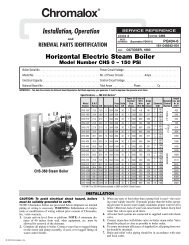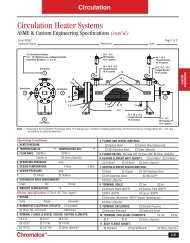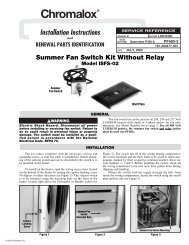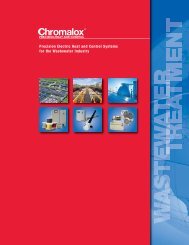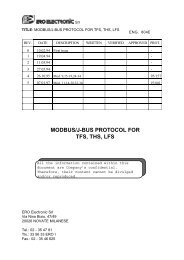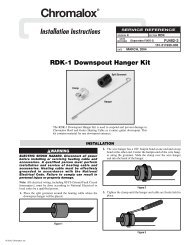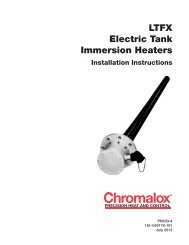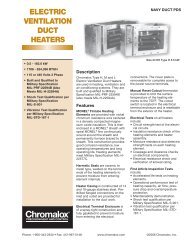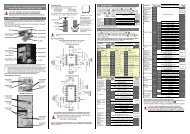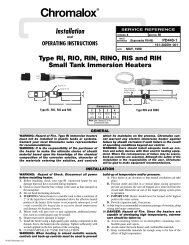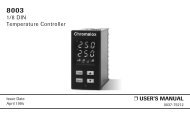Cold Weather Catalog - Chromalox Precision Heat and Control
Cold Weather Catalog - Chromalox Precision Heat and Control
Cold Weather Catalog - Chromalox Precision Heat and Control
- No tags were found...
Create successful ePaper yourself
Turn your PDF publications into a flip-book with our unique Google optimized e-Paper software.
TechnicalTechnical Information<strong>Heat</strong> Transfer Fundamentals & Thermodynamic Properties<strong>Heat</strong> Transfer FundamentalsThe principles of heat transfer are well understood<strong>and</strong> are briefl y described below. <strong>Heat</strong>energy is transferred by three basic modes. Allheating applications involve each mode to agreater or lesser degree.• Conduction• Convection• RadiationConduction is the transfer of heat energythrough a solid material. Metals such ascopper <strong>and</strong> aluminum are good conductorsof heat energy. Glass, ceramics <strong>and</strong> plasticsare relatively poor conductors of heat energy<strong>and</strong> are frequently used as thermal insulators.All gases are poor conductors of heat energy.A combination of exp<strong>and</strong>ed glass or ceramicfi ber fi lled with air is excellent thermal insulation.Typical conduction heating applicationsinclude platen heating (cartridge heaters), tankheating (strip <strong>and</strong> ring heaters), pipe tracing<strong>and</strong> other applications where the heater is indirect contact with the material being heated.Convection is the transfer of heat energy bycirculation <strong>and</strong> diffusion of the heated media.It is the most common method of heatingfl uids or gases <strong>and</strong> also the most frequentapplication of electric tubular elements <strong>and</strong>assemblies. Fluid or gas in direct contactwith a heat source is heated by conductioncausing it to exp<strong>and</strong>. The exp<strong>and</strong>ed materialis less dense or lighter than its surroundings<strong>and</strong> tends to rise. As it rises, gravity replacesit with colder, denser material which is thenheated, repeating the cycle. This circulationpattern distributes the heat energy throughoutthe media. Forced convection uses the sameprinciple except that pumps or fans move theliquid or gas instead of gravity.Convection in a LiquidElectric<strong>Heat</strong>erLiquidTypical convection heating applications includewater <strong>and</strong> oil immersion heating, air heating,gas heating <strong>and</strong> comfort air heating.Radiation is the transfer of heat energy byelectromagnetic (infrared) waves <strong>and</strong> is verydifferent from conduction <strong>and</strong> convection.Conduction <strong>and</strong> convection take place whenthe material being heated is in direct contactwith the heat source. In infrared heating, thereis no direct contact with the heat source. Infraredenergy travels in straight lines throughspace or vacuum (similar to light) <strong>and</strong> doesnot produce heat energy until absorbed. Theconverted heat energy is then transferred inthe material by conduction or convection.Radiant Energy (Infrared) <strong>Heat</strong>ingAll objects above “absolute zero” temperatureradiate infrared energy with warmer objectsradiating more energy than cooler objects.Infrared energy radiating from a hot object(heating element) strikes the surface of acooler object (work piece), is absorbed <strong>and</strong>converted to heat energy. Paint drying by radiantheaters is a typical application of infraredheating. The most important principle ininfrared heating is that infrared energy radiatesfrom the source in straight lines <strong>and</strong> does notbecome heat energy until absorbed by thework product.Thermodynamic PropertiesAll materials have basic physical constants<strong>and</strong> thermodynamic properties. Theseconstants are used in the evaluation of thematerials <strong>and</strong> in heat energy calculations. Theconstants <strong>and</strong> properties most often used are:• Specifi c <strong>Heat</strong> (C p)• <strong>Heat</strong> of Fusion (H fus)• <strong>Heat</strong> of Vaporization (H vap)• Thermal Conductivity (k)• Thermal Resistivity (R)Specifi c <strong>Heat</strong> (Quantity of <strong>Heat</strong> Energy) — Allmaterials contain or absorb heat energy indiffering amounts. The quantity of heat energyor thermal capacity of a particular material iscalled its specifi c heat.The specifi c heat of a substance is defi ned asthe amount of heat energy required to raise onepound of the material by one degree Fahrenheit.Specifi c heat factors are usually defi nedas British thermal units per pound per degreeFahrenheit (Btu/lb/°F). The specifi c heat ofmost materials is constant at only one temperature<strong>and</strong> usually varies to some degree withtemperature. Water has a specifi c heat of 1.0<strong>and</strong> absorbs large quantities of heat energy. Air,with a specifi c heat of 0.24, absorbs considerablyless heat energy per pound.<strong>Heat</strong> of Fusion or Vaporization — Manymaterials can change from a solid to a liquidto a gas. For the change of state to occur,heat energy must be added or released. Wateris a prime example in that it changes from asolid (ice) to a liquid (water) to a gas (steamor vapor). If the change is from a solid to aliquid to a gas, heat energy is added. If thechange is from a gas to a liquid to a solid, heatenergy is released. These energy requirementsare called the heat of fusion <strong>and</strong> the heat ofvaporization. They are expressed as Btu perpound (Btu/lb).• <strong>Heat</strong> of Fusion is the amount of energyrequired to transform a material from asolid to a liquid (or the reverse) at the sametemperature. Water has a heat of fusion of143 Btu/lb.• <strong>Heat</strong> of Vaporization is the amount ofenergy required to transform a materialfrom a liquid to a gas (or the reverse) at thesame temperature. Water has a high heat ofvaporization, 965 Btu/lb. Water can transferlarge amounts of heat energy in the form ofcondensing steam.Thermal Conductivity is the ability of a materialto transmit heat energy by conduction.Thermal conductivity is identifi ed as “k” <strong>and</strong>is usually expressed in British thermal unitsper linear inch (or foot) per hour per squarefoot of area per degree Fahrenheit. (Btu/in/hr/ft 2 /°F) or (Btu/ft/hr/ft 2 /°F). “k” factors are usedextensively in comfort heating applications torate the effectiveness of building construction<strong>and</strong> other materials as thermal insulation. “k”factors are also used in the calculation of heatlosses through pipe <strong>and</strong> tank insulation.Thermal Resistivity or “R” is the inverse ofthermal conductivity. Insulating materials arerated by “R” factors. The higher the “R” factor,the more effective the insulation.TECHNICAL177




